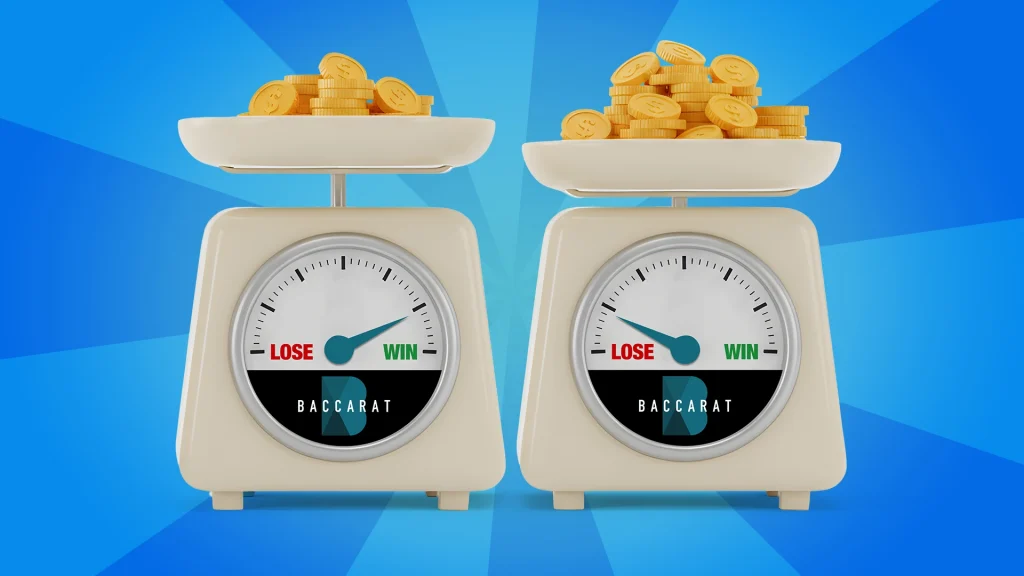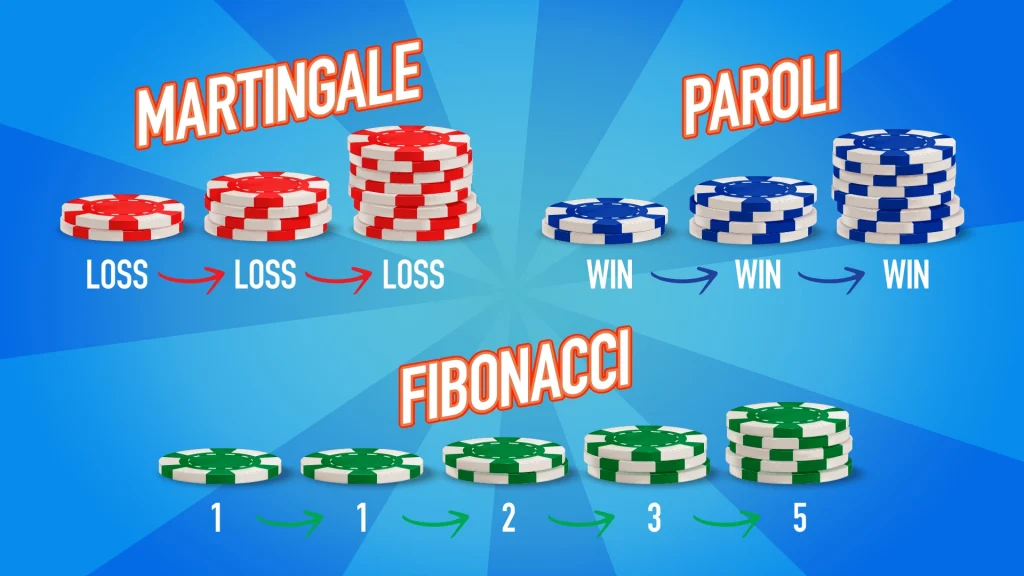Keep Calm & Carry On with D’Alembert in Baccarat
If Martingale gives you heart palpitations and Oscar’s Grind puts you to sleep, the D’Alembert strategy in baccarat is your happy place. It’s the lower volatility, “keep calm and carry on” of baccarat betting strategies because it gradually nudges your bets up and down without lighting your bankroll on fire.
The TL;DR is to increase your bet after a loss and decrease it after a win. In that spirit, this guide aims to increase your knowledge and decrease your doubt. Follow us and let’s walk the one-up, one-down D’Alembert walk.
Baccarat Brush-up
Before we dive into the mathy part (don’t worry, it’s not that mathy), let’s get on the same page about baccarat. It’s one of the easiest games for beginners because it’s essentially a guessing game that dons a tuxedo (thanks, James Bond).
You’re betting on whether the Player or Banker hand will get closer to nine or if they’ll tie. But betting on a tie has such a low probability of winning, you’d have a better chance of watching theEagles vs. Cowboys without yelling at the screen. In other words, it’s possible, but it’s just not worth it.
The Player and Banker bets in baccarat have a roughly 45% chance of winning and pay even money, making them the ideal building blocks to use the D’Alembert system in baccarat.
What is the D’Alembert strategy in baccarat?
To use the baccarat D’Alembert system, you increase your bet by one unit after every loss, and decrease it by one after every win. The idea is that wins and losses tend to even out over time, so you slowly climb your way back to profit without spiraling into martingale territory, which requires doubling your bet after each loss.
The History of the D’Alembert System
If you have a beverage in hand – a Berry Bloomed iced tea, perhaps – raise a toast to a gentleman named Jean-Baptiste le Rond d’Alembert. He was the 18th-century French mathematician who invented the D’Alembert system.
He based his method on the mathematical principle of equilibrium, the idea that everything eventually balances out. In this case, the “everything” is your wins and losses, politely taking turns like civilized adults.
D’Alembert Betting System Example With Baccarat

Let’s spell it out clearly with a few examples.
First, set up your base unit at, let’s say, $10, and stick with the Banker bet since statistically, it wins slightly more often. The rule is to add one unit after a loss and subtract one unit after a win. Never drop below your base bet, or, in other words, don’t bet below your starting amount ($10 in this example), no matter how many times you win.
Now let’s review a few scenarios so you know how it’ll look.
Scenario A: Early losses, slow recovery (the classic D’Alembert arc)
- Hand 1: Bet $10 (lose) → next bet $20
- Hand 2: Bet $20 (lose) → next $30
- Hand 3: Bet $30 (win) → next $20
- Hand 4: Bet $20 (win) → next $10
- Hand 5: Bet $10 (win) → stay $10 (don’t bet below your base)
Takeaway: In this example, you took two hits and then three wins stair-stepped you back toward even. This represents the mindset that defines D’Alembert: “Bear the heat, don’t add fuel.”
Scenario B: Choppy shoe (win/lose ping-pong)
- Hand 1: $10 (win) → $10
- Hand 2: $10 (lose) → $20
- Hand 3: $20 (win) → $10
- Hand 4: $10 (lose) → $20
- Hand 5: $20 (lose) → $30
- Hand 6: $30 (win) → $20
Takeaway: A series of wins and losses gently nudged you up and down, ending with a decent profit. However, as we see after the second loss, your bets can grow fairly large on a losing streak.
Scenario C: Heater (wins first, then a speed bump)
- Hand 1: $10 (win) → $10
- Hand 2: $10 (win) → $10
- Hand 3: $10 (win) → $10
- Hand 4: $10 (lose) → $20
- Hand 5: $20 (win) → $10
Takeaway: The D’Alembert doesn’t “punish” you for winning streaks by doubling or overreacting when you lose. You stay steady at your base bet until a loss nudges you up slightly, then reset.
Pros And Cons Of Using The D’Alembert Strategy With Baccarat
We call the D’Alembert strategy the “keep calm and carry on” of betting because you’re simply nudging your bet up or down each round, causing very little reason for stress when you hit losses.
Because you only move one unit at a time, you don’t need a massive balance to play. As long as you’re playing a game with near 50/50 chances, like player/banker in baccarat or outside bets in roulette, the D’Alembert system balances out wins and losses fairly well. You win more gradually, but the risk is drastically reduced.
There are downsides, too. If you hit a long losing streak, those single-unit steps can add up, and they won’t cover losses fast enough. You’ll need significant patience (and maybe caffeine for the slow grind to recovery). It also can’t magically change baccarat’s house edges. Like all baccarat strategies, it’s a money-management approach, not a secret win code.
You’ll still lose sometimes, maybe even often. But with D’Alembert, you’ll lose calmly, more like “Ah. Dang” when you add another unit, and less like “NOOOO!” with an accompanying keyboard smash. And that’s the kind of balance we want to see when gambling online.
Another way to achieve perfect balance while gambling is to deposit with crypto. Baccarat can be played as crypto gaming, which means your deposit clears faster and with fewer fees, while you still view your game in familiar USD.
How does it compare to other baccarat betting strategies?

The D’Alembert system sits comfortably between the high-risk all-or-nothing escalation of Martingale and the optimism of Paroli.
The Martingale system in baccarat doubles down after every loss. You end up risking huge swings for small gains. In comparison, D’Alembert is more measured. You increase or decrease by just one unit, trading speed for sustainability. You’ll recover slower, but you won’t torch your bankroll in five losing hands.
The Paroli system, on the other hand, rides hot streaks by doubling your bet after each win. Again, D’Alembert is steadier and more defensive. While Paroli thrives on momentum, D’Alembert survives in balance, adjusting to both wins and losses.
Another popular betting system is Fibonacci, where you adjust your bets following the famous mathematical sequence: 1, 1, 2, 3, 5, and so on. It’s a little more methodical than D’Alembert and can recover losses faster. But that same pattern also means bets climb faster than you’d expect, especially after a string of losses. D’Alembert, by comparison, is more grounded and simple: one step up, one step down.
For the opportunity to go exclusively up up up, refer a friend to play at Cafe Casino. We’ll drop you a cash bonus to boost your bankroll after they sign up and make a deposit.
A little give, a little take. That’s the D’Alembert handshake. Okay…so we won’t be winning any Pulitzers any time soon, but that little diddy sums up the concept behind the baccarat D’Alembert strategy. It’s slow, steady, and perfectly balanced, just as your bankroll likes it. Put the one-up, one-down rhythm to work with baccarat at Cafe Casino, and see if your calm, cool, and collected strategy pays off.